
Westringia is a genus of Australian shrubs. As with other members of the mint family their upper petal is divided into two lobes. There are four stamens - the upper two are fertile while the lower two are reduced to staminodes. The leaves are in whorls of 3 or 4.

Westringia fruticosa, the coastal rosemary or coastal westringia, is a shrub that grows near the coast in eastern Australia.
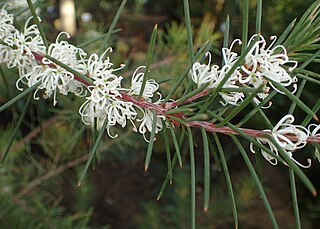
Hakea sericea, commonly known as bushy needlewood or silky hakea, is a large shrub with a profusion of mainly white flowers from July for several months. It is endemic to eastern Australia. It has become an environmental weed in some countries.

Hibbertia sericea, commonly known as silky guinea-flower, is a species of flowering plant in the family Dilleniaceae and is endemic to south-eastern Australia. It is an erect or spreading shrub with softly-hairy branches, elliptic to egg-shaped leaves with the narrower end towards the base, and yellow flowers with eight to fourteen stamens in a cluster on one side of two hairy carpels.

Hemigenia is a genus of flowering plants in the mint family, Lamiaceae and is endemic to Australia where most species occur in Western Australia, although some are also found in New South Wales and Queensland. Plants in this genus are shrubs or bushes with simple leaves and tube-shaped flowers with the petals forming two "lips" - the upper one with two lobes and the lower one with three.
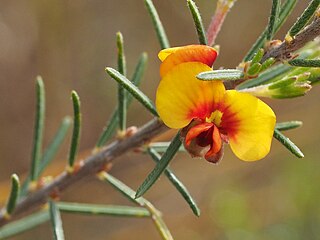
Dillwynia sericea, commonly known as showy parrot-pea, is a species of flowering plant in the family Fabaceae and is endemic to south-eastern Australia. It is an erect to low-lying shrub with hairy stems, linear leaves and apricot-coloured flowers, usually with a red centre.
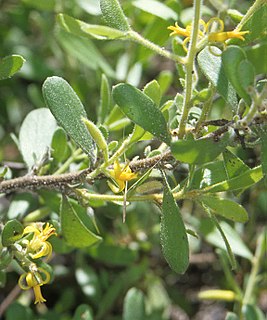
Persoonia sericea, commonly known as the silky geebung, is a plant in the family Proteaceae and is endemic to eastern Australia. It is a shrub with hairy yellow flowers and silky-hairy young branches and leaves.

Westringia eremicola, commonly known as slender westringia or slender western rosemary, is a flowering plant in the family Lamiaceae and is endemic to eastern Australia. It is a small shrub, with narrow leaves and pink, mauve to white flowers.

Patersonia sericea, commonly known as purple flag or silky purple-flag is a species of plant in the iris family Iridaceae and is endemic to eastern Australia. It is a densely-tufted perennial herb with linear, sword-shaped leaves, broadly egg-shaped, bluish-violet tepals and an oval capsule.

Hakea actites, commonly known as the mulloway needle bush or wallum hakea is a shrub or tree of the Proteacea family native to areas in north eastern New South Wales and south eastern Queensland. White nectar rich flowers appear in abundance from late autumn to early spring.
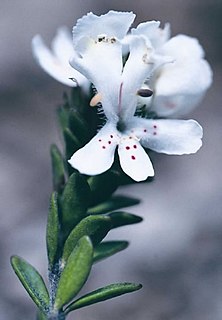
Westringia kydrensis, also known as the Kydra Westringia, is a species of plant in the mint family that is endemic to Australia.

Westringia saxatilis is a species of plant in the mint family that is endemic to Australia.

Westringia davidii, also known as David's Westringia, is a species of plant in the mint family that is endemic to Australia.
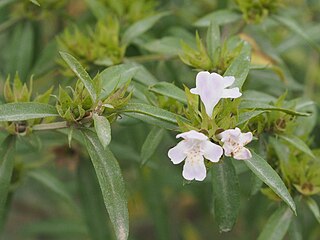
Westringia amabilis is a species of flowering plant in the family Lamiaceae and grows in New South Wales and Queensland. It is a small shrub with ovate-shaped leaves and light mauve to white flowers and brownish spots in the throat.

Westringia parvifolia is a species of plant in the mint family that is endemic to Australia.

Westringia lucida, also known as Shining Westringia, is a species of plant in the mint family that is endemic to Australia.

Westringia blakeana is a flowering plant in the family Lamiaceae and grows in New South Wales and Queensland. It is a small shrub with mauve to whitish flowers with brown spots and leaves arranged in whorls.
Westringia longepedunculata is a species of plant in the mint family that is endemic to Australia. It is found in south-eastern Queensland, and is sometimes considered to be a synonym of Westringia cheelii.

Westringia rupicola is a species of plant in the mint family that is endemic to Australia.

Westringia cheelii is a species of plant in the mint family that is endemic to Australia.



















